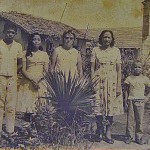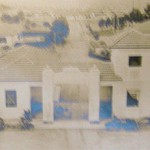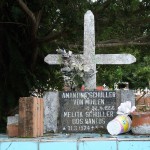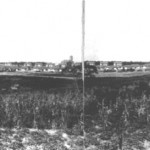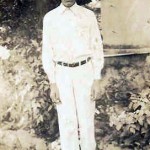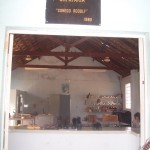
Brazil

Map showing leprosy organisations in Brazil in 1936
According to Maurano (1944), the Portuguese were responsible for introducing leprosy to Brazil. Hypotheses about the origin of leprosy in this region support what is now known from genomics about the spread of M. leprae. It appears that the disease arrived with in Rio de Janeiro, Salvador and Recife, at the end of the sixteenth and beginning of the seventeenth centuries. (Maurano) It came with European immigrants and African slaves.
In 1640, what was known as Campo dos Lázaros (Leprosy Camp), in Bahia, Brazil was situated two miles from the Fortalezo de Nazaré do Cabo (Fort of Cape Nazareth). The governor of the city of Rio de Janeiro called for a report on the prevalence of leprosy in the city on 1696. (Souza Araújo) The following year he asked the king to authorise the construction of a leprosy hospital. By 1740, the King of Portugal, Dom João V, ordered Dr Euzebio Ferreira to study the subject of leprosy in Rio de Janeiro. Drs Francisco Teixeira and Jose Rodrigues, of Lisbon were appointed to plan a strategy for leprosy control in Brazil. As a result, the first anti-leprosy law for Brazil was drawn up by a committee of three Lisbon doctors. They regarded leprosy to be a contagious disease of greater or less degree according to its clinical type, and they recommended segregation of all confirmed cases. Eventually, in 1763, the Catholic Fraternity “Irmandade da Candelaria” took over the leprosy asylum in Rio de Janeiro which was called the Hospital dos Lázaros. Meanwhile, asylums were established elsewhere in Brazil; for example, in Bahia, in 1787, São Christovam dos Lazaros; and two years later, the Hospital dos Lazaros of Recife was established in Pernambuco. In 1815, the Governor, Count dos Arcos, built an asylum at the Hospital dos Lazaros, Santa Casa da Misericordia, in Tocunduba, near Belém, in Pará.
In the early twentieth century, Emílio Ribas called the government’s attention to the constant rise in leprosy cases, and proposed isolation in ‘asilos-colônia’, where the patients should lead a life similar to that of healthy people.(Maurano) At the American International Leprosy Congress in Rio de Janeiro, Carlos Chagas approved a raft of anti-leprosy measures that included leprosy censuses for all Brazilian states; consolidation of the different anti-leprosy legislation in force; opening of colonies; implementing a uniform plan to combat the disease, to be applied simultaneously across the whole country; permitting, in certain circumstances, isolation at home; and providing specialist treatment for patients. (Velloso)
A National Department of Public Health was formed in 1920 (Departamento Nacional de Saúde Pública), with an “Inspectoria de Prophylaxia da Lepra”. It estimated that there were 12,000 people with leprosy in Brazil. (Souza Araújo) Carlos Chagas was its architect. This was the first time that anti-leprosy activities were organised as a matter of public health. The end result was that from 1927 onwards, people were systematically isolated.
By 1929, estimates have increased significantly. Out of a population of 36,000,000, there are 24,000 people with leprosy: i.e. 0.67 per 1000 according to Souza Araújo. There were major foci in the States of Amazonas, Pará, Maranhão, Minas Gerais, São Paulo and minor foci the north east and south of Brazil. At this time, there were leprosy asylums in the following states:
Hospital dos Lazaros of Rio de Janeiro
Hospital dos Lazaros of São Salvador, Bahia
Hospital dos Lazaros of Recife, Pernambuco
Hospital dos Lazaros of Tocunduba, Belem, Para
Hospital dos Lazaros of Sabara, Minas Gerais
Hospital dos Lazaros of Guapira, São Paulo (1904)
New leprosaria were planned or already established in the following:
Lazaropolis do Prata, Pará (1924)
Leprosario Santa Angelo founded by Santa Casa da Misericordia (1928)
Leprosario São Luiz, St Luiz
Leprosario Santa Izabel, of Minas Gerais
Leprosario de Paricatuba, Estado do Amazonas
States of Ceará and Rio Grande do Norte
In 1946, an extensive leprosy census was carried out for the whole of Brazil by Ernani Agrícola, under the supervision of the National Department of Health (Departamento Nacional de Saúde) of the Ministry of Education and Health (Ministério da Educação e Saúde). The results showed a constant rise in the number of new cases, while the prevalence level showed that the increase of the disease had not been detected, leading to a conclusion that the ‘tripé’ (triple action of leprosários (where patients with advanced leprosy were kept), dispensários (which had the function of examining those in contact with patients, suspected cases and less advanced cases, and preventórios (where children of parents with leprosy were brought up and educated, away from their parents.) was an insufficient measure in impeding the propagation of the disease.(Velloso)
In 1948, when dapsone treatment became available, a National Leprosy Campaign (Campanha Nacional de Lepra) commenced in 1950 and ended in 1964, at which time leprosy responsibility for leprosy control was transferred from the national to the state level.
One notable event coming out of the Eighth International Leprosy Congress in Rio de Janeiro (1963), held by the International Leprosy Association, was the elimination of the derogatory term “leper” as a medical category.
Between 1986 and 1990, the Projeto de Intervenção in Brazil led to the elaboration of the Plano de Emergência Nacional. Brazil is still battling leprosy, but the numbers of new cases have gone down. Between 2011 and 2013, the 10 most endemic clusters are mainly located in the states of Mato Grosso, Pará, Maranhão, Tocantins, Goiás, Rondônia and Bahia. They represent 44% (13,597 / 31,044) of new cases diagnosed in 2013. (WHO)
Antonio Diogo
- Access to the inner area of the Colony Antônio Diogo
- The residents gathered around the coluna da hora (clock tower) in Antônio Diogo
- Entrance to the colony
- Inner garden of the colony
Antonio Justa
- Christmas gathering at Antonio Justa, 1978
- Group of students at Antonio Justa, 1978
- Entrance to the colony
- The community centre of Antonio Justa Colony, now transformed into a church
- Christmas at Antonio Justa, 1978
- Christmas celebrations, 1978
Bomfim
- Buildings at the Bomfim colony, São Paulo
- Church at Bomfim
- Gardens at Bomfim
- Views near Bomfim
- Buildings at Bomfim
- Buildings at Bomfim
- Residents of the Bomfim colony
- Residents of the Bomfim colony
- Football team at Bomfim
- Residents of the Bomfim colony
- A man with a bicycle at Bomfim
- A funeral in the colony of Bomfim
- A street in Bomfim
- Buildings at Bomfim
Cocais
- Entrance to the Cocais colony
- Aerial view of Cocais
Curupaiti
- Buildings at the Curupaití colony
- Housing at Curupaití
- Residents at Curupaití
- Dwellings at Curupaití
- Curupaití during the Festa Junina (June Festival), 2007
Frei Antonio
- The grounds of Frei Antônio
- The interior of Frei Antônio
- Stained glass window depicting Christ bringing hope to the leprosy affected
- Entry to Frei Antônio with the inscription ‘Here Hope is Reborn’; this was changed from an earlier one that exhorted those who entered the hospital to renounce all hope.
Itapua
- The cemetery in Itapuã
- The cemetery in Itapuã
- The cemetery in Itapuã
- Ruins of the church in Itapuã
- The church in Itapuã
- An aerial view of Itapuã
- A view of houses and the church in Itapuã
- A residential area in Itapuã
- Pavilions in the colony of Itapuã
- The entrance to the colony of Itapuã
- Houses in Itapuã
- The theatre in Itapuã
Padre Bento
- Aerial view of the Sanatorio Padre Bento
- Another view of the Sanatorio Padre Bento
- Dance hall in the Sanatorio Padre Bento
Pirapitingui
- A view of the housing at the Pirapitinguí colony
- A sign forbidding visitors from accessing patient areas (1946)
- The jail for inmates at Pirapitinguí
- Interior of the jail
- A building at Pirapitinguí
- Historical view of the colony
Santa Marta
- The water fountain in the Colônia Santa Marta, Goiás
- Residents by the water fountain
- The water fountain today
- A street in the colony
- People in the Colônia Santa Marta, Goiás
- Francisco A. V. Nunes, “Bacurau” (right), human rights advocate and community leader
- Children outside the colony’s school
- People in the Catholic church at Santa Marta
- People in the Catholic church at Santa Marta
- A Catholic wedding reception in Santa Marta
- A Catholic wedding reception in Santa Marta
- Resident of the Colônia Santa Marta, Goiás
- A couple in the Colônia Santa Marta, Goiás
- More of the colony’s residents
- A young boy in Santa Marta
- Residents in the Catholic church
- Construction of the Catholic church at Santa Marta
- Sister Natália Dornelas, one of the colony’s first workers
- Entry to the Colônia Santa Marta today
- Men’s pavilions in Santa Marta
- Women’s pavilions in Santa Marta
- The Catholic church in Santa Marta today
- Former nuns’ dwellings
- The old hospital in the colony, undergoing renovations
- Evangelical church
- Ruins of the old men’s pavilions
- Gates of one of the colony’s cemeteries, in which 127 people are interred
- Residents’ association
- Shoe store in the colony
- A shrine in the gardens of Santa Marta
- Information centre, school, and clothing store
Santa Terezinha
- Aerial drawing of the Preventório Santa Terezinha, São Paulo
- Buildings in Santa Terezinha
- Children at Santa Terezinha
- Children at Santa Terezinha
- Children at Santa Terezinha
- Children at Santa Terezinha
- Infirmary at Santa Terezinha
- Boys working in the fields at Santa Terezinha
Santo Angelo
- Entrance to the Colony Santo Angelo
- Aerial view of Santo Angelo
Sources
F. Maurano, Tratado de leprologia. História da lepra no Brasil e sua distribuição geográfica. Rio de Janeiro: Ministério da Educação e Saúde. Departamento Nacional de Saúde. Serviço Nacional de Lepra, 1944. V.1, pp. 16-19. Cited in: AP Velloso, & V Andrade, Hanseníase: curar para eliminar. Porto Alegre, 2002.
H. C. de Souza Araújo, História da lepra no Brasil. Rio de Janeiro: Imprensa Nacional, 1946. Cited in: AP Velloso,& V Andrade, Hanseníase: curar para eliminar. Porto Alegre, 2002.
H. C. de Souza Araújo, “The Leprosy Problem in Brazil” Am J Trop Med, May 1925.
WHO http://www.who.int/lep/resources/Cluster_analysis/en/ December 12, 2015




















